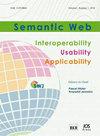实现本体的反事实解释
IF 3
3区 计算机科学
Q2 COMPUTER SCIENCE, ARTIFICIAL INTELLIGENCE
引用次数: 0
摘要
自网络本体语言(OWL)成为 W3C 建议以来,调试和修复网络本体语言(OWL)本体一直是一个重要的研究领域。理解错误和修复错误的一种方法是通过解释。这些解释通常是从推理器中提取的,并按原样显示给本体作者。与此同时,最近在可解释人工智能(XAI)领域出现了使用知识图谱和本体形式的专家知识的呼声。本文将对机器学习和本体进行平行解释。这种联系使 XAI 方法能够解释本体及其蕴涵。反事实解释被认为是解决机器学习中可解释性问题的最佳候选方案。因此,我们提出了 CEO(本体的反事实解释)方法,利用反事实解释来解释不一致的本体。我们进行了一项初步的用户研究,以确保在本体中使用 XAI 方法是有意义的、值得追求的。本文章由计算机程序翻译,如有差异,请以英文原文为准。
Towards counterfactual explanations for ontologies
Debugging and repairing Web Ontology Language (OWL) ontologies has been a key field of research since OWL became a W3C recommendation. One way to understand errors and fix them is through explanations. These explanations are usually extracted from the reasoner and displayed to the ontology authors as is. In the meantime, there has been a recent call in the eXplainable AI (XAI) field to use expert knowledge in the form of knowledge graphs and ontologies. In this paper, a parallel between explanations for machine learning and for ontologies is drawn. This link enables the adaptation of XAI methods to explain ontologies and their entailments. Counterfactual explanations have been identified as a good candidate to solve the explainability problem in machine learning. The CEO (Counterfactual Explanations for Ontologies) method is thus proposed to explain inconsistent ontologies using counterfactual explanations. A preliminary user study is conducted to ensure that using XAI methods for ontologies is relevant and worth pursuing.
求助全文
通过发布文献求助,成功后即可免费获取论文全文。
去求助
来源期刊

Semantic Web
COMPUTER SCIENCE, ARTIFICIAL INTELLIGENCEC-COMPUTER SCIENCE, INFORMATION SYSTEMS
CiteScore
8.30
自引率
6.70%
发文量
68
期刊介绍:
The journal Semantic Web – Interoperability, Usability, Applicability brings together researchers from various fields which share the vision and need for more effective and meaningful ways to share information across agents and services on the future internet and elsewhere. As such, Semantic Web technologies shall support the seamless integration of data, on-the-fly composition and interoperation of Web services, as well as more intuitive search engines. The semantics – or meaning – of information, however, cannot be defined without a context, which makes personalization, trust, and provenance core topics for Semantic Web research. New retrieval paradigms, user interfaces, and visualization techniques have to unleash the power of the Semantic Web and at the same time hide its complexity from the user. Based on this vision, the journal welcomes contributions ranging from theoretical and foundational research over methods and tools to descriptions of concrete ontologies and applications in all areas. We especially welcome papers which add a social, spatial, and temporal dimension to Semantic Web research, as well as application-oriented papers making use of formal semantics.
 求助内容:
求助内容: 应助结果提醒方式:
应助结果提醒方式:


